Introduction
In recent years, wearable technology has emerged as one of the most dynamic and transformative sectors in the tech industry. From humble beginnings as simple pedometers to today’s sophisticated smartwatches and augmented reality glasses, wearables have evolved into indispensable tools that seamlessly integrate into our daily lives. These devices are no longer just gadgets; they are extensions of ourselves, offering unparalleled convenience, insight, and connectivity. As society becomes increasingly reliant on data-driven solutions, wearables stand at the forefront of this shift, empowering individuals to monitor their health, enhance productivity, and stay connected like never before. The growing role of wearables in modern life underscores their potential to redefine how we interact with technology—and each other.
Current State of Wearable Technology
Today’s wearable market is dominated by a diverse range of devices, each tailored to specific needs and preferences. Smartwatches, such as those from Apple, Samsung, and Garmin, have become ubiquitous, serving as multifunctional companions that track fitness metrics, deliver notifications, and even facilitate mobile payments. Fitness trackers like Fitbit continue to gain popularity for their ability to monitor physical activity, heart rate, and sleep patterns, making them essential tools for health-conscious users. Meanwhile, augmented reality (AR) glasses, exemplified by products like Microsoft’s HoloLens and Google Glass Enterprise Edition, are carving out niches in professional environments, enabling hands-free access to information and immersive training experiences.
These devices are not limited to health and entertainment alone. They also play a critical role in enhancing communication and productivity. For instance, voice-activated assistants integrated into wearables allow users to send messages, schedule appointments, or control smart home devices without needing to reach for their phones. In addition, wearables are increasingly being used for immersive entertainment, with features like music streaming, GPS navigation, and even gaming capabilities. This versatility highlights how wearables have transitioned from novelty items to practical, everyday essentials.
Innovations Driving the Future
The rapid pace of technological advancement is propelling wearables into uncharted territory, unlocking possibilities that were once confined to science fiction. Artificial intelligence (AI) is at the heart of this transformation, enabling wearables to process vast amounts of data in real time and provide personalized insights. For example, AI-powered algorithms can analyze sleep patterns to recommend optimal bedtime routines or detect anomalies in heart rate variability that may indicate underlying health issues.
Advanced sensors are another cornerstone of innovation, allowing wearables to capture more nuanced biometric data than ever before. Devices capable of measuring blood oxygen levels, glucose concentrations, and even hydration status are already making waves in the healthcare sector. Additionally, flexible displays and self-healing materials are pushing the boundaries of design, creating wearables that are not only functional but also comfortable and durable. Extended battery life, achieved through energy-efficient components and wireless charging technologies, ensures these devices remain operational throughout the day.
Looking further ahead, groundbreaking concepts like brain-computer interfaces (BCIs) and emotion-sensing wearables could revolutionize human-device interaction. BCIs, which translate neural signals into digital commands, hold promise for individuals with mobility impairments, while emotion-sensing wearables could pave the way for mental health applications by detecting stress, anxiety, or excitement based on physiological cues.
Impact on Health and Wellness
One of the most profound impacts of wearable technology lies in its ability to transform healthcare delivery. By providing continuous, real-time monitoring of vital signs, wearables empower users to take charge of their own well-being. For instance, devices equipped with electrocardiogram (ECG) functionality can alert users to irregular heart rhythms, potentially preventing serious cardiac events. Similarly, glucose-monitoring wearables offer diabetics a non-invasive alternative to traditional finger-prick tests, improving both convenience and compliance.
On a broader scale, wearables are facilitating the rise of personalized medicine, where treatments are tailored to an individual’s unique genetic makeup and lifestyle factors. Remote patient monitoring, enabled by wearable devices, allows healthcare providers to track patients’ conditions outside clinical settings, reducing hospital readmissions and lowering costs. Early disease detection is another area where wearables shine, as subtle changes in biometric data can serve as early warning signs of conditions like hypertension or sleep apnea.
Mental health support is yet another frontier being explored. Wearables equipped with mindfulness apps, stress management tools, and mood-tracking features are helping users manage anxiety, depression, and other psychological challenges. Collectively, these advancements are reshaping healthcare systems, fostering a shift toward proactive, preventive care models.
Enhancing Productivity and Connectivity
Beyond personal use, wearables are proving invaluable in professional settings, particularly when it comes to boosting productivity and ensuring safety. In industries such as manufacturing, logistics, and construction, wearable devices equipped with environmental sensors can monitor air quality, temperature, and hazardous conditions, safeguarding workers’ health. Similarly, exoskeletons and ergonomic wearables are being developed to reduce physical strain during repetitive tasks, minimizing workplace injuries.
Hands-free operations represent another significant advantage of wearables in the workplace. AR glasses, for example, enable technicians to access schematics or instructional videos while performing complex repairs, streamlining workflows and reducing errors. Real-time language translation features embedded in earbuds or smart glasses are breaking down communication barriers in global teams, fostering collaboration across borders.
Even in personal contexts, wearables enhance connectivity by keeping users constantly informed and engaged. Whether it’s receiving calendar reminders, navigating unfamiliar cities, or staying updated on social media, these devices ensure that important information is always within reach—literally.
Challenges and Ethical Considerations
Despite their many benefits, wearables are not without challenges. Chief among these is the issue of data privacy. Wearables collect vast amounts of sensitive information, ranging from location data to biometric readings, raising concerns about how this data is stored, shared, and protected. Cybersecurity threats pose another risk, as hackers could exploit vulnerabilities in wearable ecosystems to steal personal information or disrupt device functionality.
Over-reliance on technology is another potential drawback. As wearables become more ingrained in daily routines, there is a danger that users may prioritize convenience over critical thinking, leading to diminished problem-solving skills or reduced face-to-face interactions. Accessibility remains a concern as well, given that high costs and technical complexity can exclude certain demographics from benefiting from these innovations.
To address these issues, ethical guidelines and robust regulatory frameworks must be established. Transparency in data collection practices, stringent security measures, and inclusive design principles should be prioritized to ensure that wearables serve humanity responsibly and equitably.
Future Predictions and Trends
The future of wearable technology promises to be nothing short of extraordinary. Fully immersive augmented reality experiences, powered by lightweight AR glasses and haptic feedback systems, could blur the line between the physical and digital worlds, transforming everything from education to entertainment. Self-healing materials and adaptive fabrics may give rise to wearables that repair themselves after damage or adjust their properties based on environmental conditions.
Implantable technology represents another exciting frontier. Devices embedded beneath the skin could provide continuous health monitoring without the need for external hardware, offering unprecedented levels of accuracy and convenience. Furthermore, advances in nanotechnology might lead to microscopic wearables capable of targeting specific cells or tissues for medical interventions.
As these innovations unfold, the boundaries of what wearables can achieve will continue to expand, opening doors to applications we can scarcely imagine today.
Conclusion
Wearable technology is undeniably reshaping the fabric of daily life, influencing how we manage our health, connect with others, and navigate the world around us. From enabling personalized healthcare solutions to fostering seamless productivity and connectivity, wearables are redefining what it means to live in a technologically advanced society. However, as we embrace these innovations, it is crucial to approach them with mindfulness and responsibility, addressing ethical considerations and ensuring equitable access for all.
As we stand on the cusp of a new era defined by wearable technology, one thing is clear: the choices we make today will shape the trajectory of tomorrow. By balancing progress with prudence, we can harness the full potential of wearables to create a future that is not only smarter but also kinder and more inclusive.


